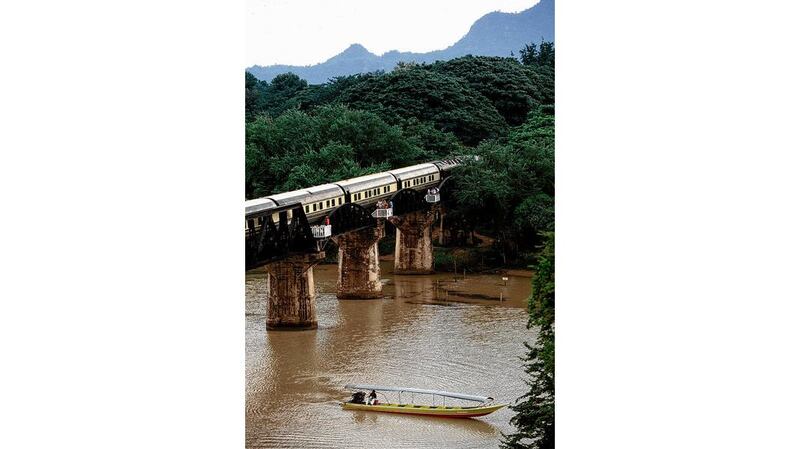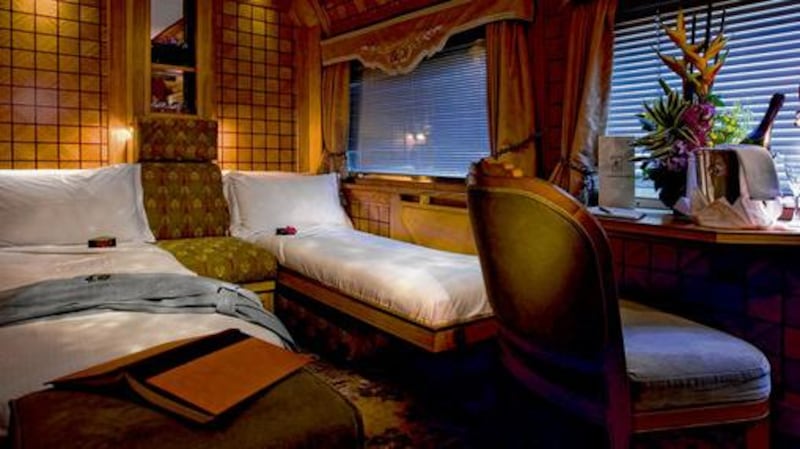It’s like that moment when the squire brings his betrothed home to the country estate: a stately line of richly-liveried men and women await me on the platform of Bangkok’s Hualamphong railway station.
There’s the train manager, the maitre d’, sous-chefs, pianist, stewards, cocktails waitresses, dancer – some of the 40 staff aboard a quarter mile of hard-furnished carriages. I am about to embark on the most decadent train trip in South East Asia: three nights aboard the Eastern and Oriental Express travelling from Bangkok, Thailand to Vientiane, Laos, and back again.
From the moment I surrendered my passport in a colonial lounge of the venerable Mandarin Oriental, Bangkok, I entered the velvet-cushioned cocoon of an Orient Express travel experience, where every whim would be accommodated and contact with the outside world was neither necessary nor desirable.


In any normal reality I would have been off exploring the delicious dirty chaos of the railway station, a faded colonial shroud of neo-Renaissance vaulting timber and stained-glass, but instead I followed as a steward bowed low and led me to my cabin – a tiny, delicately-crafted Fabergé egg of cherry-wood panelling with elm burr marquetry and burnished-brass fittings. It was like something one might see in a Sotheby’s brochure, and to actually be living in it for three nights felt surreal. The en-suite shower-room was diminutive, but a relief to have it at all, as on the Venice-Simplon Orient Express (the train’s older sister), there is only a shared WC per carriage.
My steward, having extracted a promise that I would press the bell at the first twinge of need, left me to unpack and prepare for the strict schedule ahead. There was to be a cocktail reception in the piano bar, followed by dinner and drinks. I had been warned before departure that “the train provides a marvellous opportunity to display glamour and style and dressing-up is encouraged” and was reminded once again over the tannoy that “men will feel comfortable with a jacket and tie”. Understood.
But I had underestimated the challenge of dressing while hurtling along on narrow-gauge tracks. Every movement required careful balance, adapting the equilibrium of the body to the swishing, swerving and sudden jolts of the carriage. Clothes would come swinging out of the cupboard at me, negotiating the shower required acrobatic skill and I can only imagine the motor neuron deftness required to apply make-up.
It’s not so much that the train is old – the carriages were built in the 1970s and completely overhauled in the 1990s – but the tiny track was unaccustomed to such unwieldy rolling stock, having been little improved since the Japanese came through with troops in the second World War.
Passing through the carriages was a violent ordeal. I learned to lean against the fine marquetry of the walls and slide along like a patient in a psychiatric ward.
Yet, the brute aggression of the ride, the screeching metal upon metal, the lurches and irregular rhythmic pounding became one of my favourite things – reminding me that out there, beyond this cocoon, was a real world of unpampered reality. That our lives run on uneven tracks no matter how softly we swaddle them.
In the ash-panelled bar carriage, I met my 62 fellow-passengers over champagne and despite their 17 different nationalities they were remarkably similar – ex-pats living in Singapore, Hong Kong and Kuala Lumpur, mainly involved in international business. A few were retired British couples who’d made money in the boom and now spent too much time in Dubai. There were also international financiers, engineers and import/export moguls.
We all engaged in inane chatter until dinner was served in the two dining cars, one elm-panelled and the other rosewood. Food is a primary focus of these trips, created and served from tiny galley kitchens by a French chef who, when he’s in the humour, can create dishes of genius under extraordinaryly difficult conditions. We ate goose liver wrapped in cabbage and braised lamb with celeriac purée, and then returned to the bar for a nightcap while the pianist played nostalgic melodies and the train rattled onwards through northeast Thailand towards the Mekong.
Next morning, after breakfast in my cabin, the train pulled up for a hasty excursion to Phimai, an Angkor-style Khmer temple complex with Unesco World Heritage Site status. We did a quick stroll through the ruins of old terraces, pavilions and temples decorated with bas-relief images of Shiva, Buddha and scenes from the Ramayana, before being bussed back to the train again under the stewardship of a chirpy guide twittering an anodyne spiel.
Lunch was another stylish Eurasian culinary feast served with Thai wines in fine crystal, as outside the window lush patchworks of paddy fields alternated with tapioca plantations, palm oil trees and dense areas of tropical scrubland.
The teak-panelled observation car at the rear of the train was the highlight for me – a place to escape the insulated, air-conditioned gilded cage and savour the sights and smells of the landscape as it rolled by. The country came alive here: the jungle smells of fronded leaves, dust rising from buffalo-ploughed fields, diffuse light bouncing off stagnant canals, sudden eruptions of egrets from a paddy field, monks walking with bobbing begging bowls and the aromas arising from villages as we rumbled through: lemongrass, joss-sticks and steamed rice.
The Eastern and Orient Express is a grand idea, harking back to a sanitised “colonial” age of old Siam and Malaya – of rattan chairs on the veranda, linen suits, and starched servants. As a moving, five-star hotel it enables access to remote destinations in luxury and, on some routes, allows genuine contact with tribal communities, but this trip was too contrived for me. It lacked any true connection with local people or culture, and our experience of Laos was confined to a hurried city tour of Vientiane followed by lunch in a hotel.
Yet, that said, the train is profitable for the company, and this allows them take risks with more experimental trips to Burma, South America and Botswana. Thankfully, there are plenty of rich people who wish to travel in opulence in the company of others of their kind. It’s ideal for them.
For anyone who wants to really get to know Laos, grab Dervla Murphy’s One Foot in Laos and head off into the mountains. In the seven short hours I spent there I heard an expression that makes a return trip inevitable: “In Vietnam they plant the rice, in Thailand they watch it grow, and in Laos, they listen to it grow.”
MANCHÁN MAGANwas a guest of Orient Express and Emirates
ALL YOU NEED TO KNOW
Prices start from €2,800 per person for Tales of Laos on the Eastern and Oriental Express, based on double occupancy, and includes all meals, tours and a one-night stay before and after the trip at the Mandarin Oriental, Bangkok. orient-express.com,
tel: 44-845 077-2222. Emirates fly from Dublin to Bangkok from €725 , emirates.com










